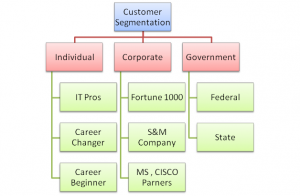Not all customers are the same. Customers are different ages, different races or ethnicities. They are of different genders; they have different levels of disposable income to spend; they live in different locations, and have different values and standards.
Customer segmentation is the practice of dividing a customer base into groups of individuals that are similar in specific ways relevant to marketing such as age, gender, interests, spending habits, and so on.
The practice of customer segmentation allows companies to target groups effectively and allocate
marketing resources to optimize the results. To do this, companies need to understand which customer segments they are targeting. All too often, you’ll hear business owners saying that “everyone” is their customer. This is not helpful from a marketing perspective. If the customer is indeed every person, it is difficult to develop a marketing campaign that will be attractive to the customer because all customers are different. It also often means that the product or service may not be specific enough to be appealing to any group of customers at all because it does not target anyone’s specific needs effectively.
Companies can use customer segmentation to:

- Develop customized marketing programs – With clear segmentation, it is possible to target marketing campaigns effectively to make sure that the widest possible audience for the product or service sees some aspect of the campaign. For example, if the product or service is targeted at a customer segment that has been identified as fairly affluent women from the ages of 18-35 who like fashion, the marketing campaign would be very different than the one for a product that was designed with the 80 year-old man in mind. The former may be targeted by placing ads in women’s magazines or carrying out social media marketing on Facebook. An 80 year-old man, however, likely does not use Facebook and probably doesn’t read women’s magazines.
- Establish appropriate service options – If a business knows which customer segments it is targeting, it can add service options to suit this group. For example, service options designed for children may not be appropriate for adults and vice versa.
- Prioritize new product development efforts – As mentioned above, savvy businesses that have identified their exact customer base can develop their product further to better suit their clientele.
- Choose specific product features – In an effective marketing campaign that is targeted at a specific customer segment, certain features of the product may be highlighted to appeal to that segment.
- Design an optimal distribution strategy – Products and services can be distributed to different segments according to their needs. For instance, let’s use the example above of a woman aged 18-35 and an 80 year old man. For the former, products might be best distributed via the Internet. The 80 year-old man may not be online, however. The best distribution channel to reach him may be his local store.
- Determine appropriate product pricing – If the customer segment targeted is a small start-up company operating on a shoestring, there is no point pricing the product at $10,000 – this will be out of range for most start ups. It does not matter how good the product is; success depends on effective product pricing according to customer segment.
The market can be segmented in so many ways, and there is no “one-size-fits-all” approach. The best way to segment the market depends on the specific business and its products or services. Here are some ideas of how this may be done:
- Geography –Where does the customer reside?
- Industry – What business is the customer in?
- Customer size – How big is the customer?
- Benefits – What benefit does the customer seek?
- Customer behavior – Who are the key buying decision makers?
My company, Information Technology (www.netcomlearning.com), targets business customers or B2B. As an example, here is a basic snapshot of customer segmentation of my company, NetCom Learning:
We target each of the above customer segments using the following criteria:
- Geography
- Job Title
- Technology Area
- Client type – existing vs. new
This allows us to develop marketing campaigns or service features that are relevant to our different segments. For example, if we are selling to a new client, we have to focus our campaign on selling the company since new clients may not be aware of who we are. However, if we are trying to sell to an existing customer, this segment already knows us, so we can focus more on selling specific features of a new service to them.



 Here are different sales channel you can use for your company:
Here are different sales channel you can use for your company:

 “Not every reader is a leader, but every leader must be a reader.” – Harry Truman
“Not every reader is a leader, but every leader must be a reader.” – Harry Truman “I can’t imagine I could become the person I am now without books. Books became synonymous with freedom. They showed that you could open doors and walk through.” – Oprah Winfrey
“I can’t imagine I could become the person I am now without books. Books became synonymous with freedom. They showed that you could open doors and walk through.” – Oprah Winfrey
